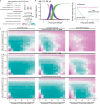A suppression-modification gene drive for malaria control targeting the ultra-conserved RNA gene mir-184
- PMID: 40280899
- PMCID: PMC12032250
- DOI: 10.1038/s41467-025-58954-5
A suppression-modification gene drive for malaria control targeting the ultra-conserved RNA gene mir-184
Abstract
Gene drive technology presents a promising approach to controlling malaria vector populations. Suppression drives are intended to disrupt essential mosquito genes whereas modification drives aim to reduce the individual vectorial capacity of mosquitoes. Here we present a highly efficient homing gene drive in the African malaria vector Anopheles gambiae that targets the microRNA gene mir-184 and combines suppression with modification. Homozygous gene drive (miR-184D) individuals incur significant fitness costs, including high mortality following a blood meal, that curtail their propensity for malaria transmission. We attribute this to a role of miR-184 in regulating solute transport in the mosquito gut. However, females remain fully fertile, and pure-breeding miR-184D populations suitable for large-scale releases can be reared under laboratory conditions. Cage invasion experiments show that miR-184D can spread to fixation thereby reducing population fitness, while being able to propagate a separate antimalarial effector gene at the same time. Modelling indicates that the miR-184D drive integrates aspects of population suppression and population replacement strategies into a candidate strain that should be evaluated further as a tool for malaria eradication.
© 2025. The Author(s).
Conflict of interest statement
Competing interests: The authors declare no competing interests.
Figures






Similar articles
-
Challenges in developing a split drive targeting dsx for the genetic control of the invasive malaria vector Anopheles stephensi.Parasit Vectors. 2025 Feb 7;18(1):46. doi: 10.1186/s13071-025-06688-0. Parasit Vectors. 2025. PMID: 39920845 Free PMC article.
-
Systematic identification of plausible pathways to potential harm via problem formulation for investigational releases of a population suppression gene drive to control the human malaria vector Anopheles gambiae in West Africa.Malar J. 2021 Mar 29;20(1):170. doi: 10.1186/s12936-021-03674-6. Malar J. 2021. PMID: 33781254 Free PMC article.
-
Modelling the suppression of a malaria vector using a CRISPR-Cas9 gene drive to reduce female fertility.BMC Biol. 2020 Aug 11;18(1):98. doi: 10.1186/s12915-020-00834-z. BMC Biol. 2020. PMID: 32782000 Free PMC article.
-
Considerations for first field trials of low-threshold gene drive for malaria vector control.Malar J. 2024 May 22;23(1):156. doi: 10.1186/s12936-024-04952-9. Malar J. 2024. PMID: 38773487 Free PMC article. Review.
-
Population modification of Anopheline species to control malaria transmission.Pathog Glob Health. 2017 Dec;111(8):424-435. doi: 10.1080/20477724.2018.1427192. Epub 2018 Feb 1. Pathog Glob Health. 2017. PMID: 29385893 Free PMC article. Review.
References
-
- World Health Organization. World Malaria Report 2023 (World Health Organization, 2023).
-
- World Health Organization. Global Technical Strategy for Malaria 2016-2030 (World Health Organization, Geneva, 2015).
MeSH terms
Substances
Grants and funding
LinkOut - more resources
Full Text Sources
Medical

